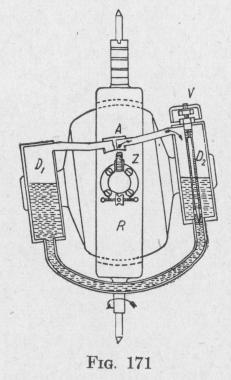218 NAVIGATIONAL COMPASSES
element. As shown in Art. 106, the spin-axle crosses the meridian plane with the north-seeking end above the horizontal plane through the center of the gyro-wheel. It does not remain in that position, but slowly describes the surface of an elliptical cone having as axis a horizontal line in the meridian plane through the center of the gyro-wheel. The control bottles and air system constitute an air pressure liquid relay that causes the statically non-pendulous sensitive element to precess into the meridian plane with the direction of spin of the gyro in the direction of rotation of the earth.
129. The Method of Damping. - The oscillation of the spin-axle back and forth across the meridian plane is due to the tilting of the spin-axle from the horizontal. The oscillations can be damped by a torque about a horizontal axis opposing the torque produced by the pendulous vertical ring and supporting frame. This counter torque will be most effective in producing damping if, at every instant, it is proportional to the angular velocity of the sensitive element about the vertical axis.
In the Brown gyro-compass this result is accomplished by the displacement of a mass of oil back and forth between two
metal bottles fastened to the opposite faces of the gyro-casing, beside the control bottles. The upper ends of these " damping bottles " are connected by small pipes to an air-box A above the upturned air-nozzle Z, Fig. 171. Note that the connections of the air-pipes from the control bottles to the air-box, Fig. 169, are not the same as the connections of the air-pipes from the damping bottles to the air-box, Fig. 171. A needle valve V controls the speed of flow of oil from one damping bottle to the other.
The operation of the damping device is as follows: Suppose that the spin-axle is horizontal and at its maximum angular displacement to the east of the meridian. The north-seeking end is at a, Fig. 137. The oil is at the same level in the control bottles, and also in the damping bottles. As the earth carries the gyro-compass from the position X to the position Y, Fig. 170, the spin-axle tilts, oil is forced from the lower control bottle into the upper, and the spin-axle turns toward the meridian. When the meridian plane is
THE BROWN GYRO-COMPASS 219
being crossed, the tilt of the spin-axle is maximum, the amount of oil in the upper control bottle is maximum, and the angular velocity of the spin-axle about a vertical axis is maximum.
Meantime, oil has been moving slowly from the upper damping bottle into the lower. So long as the spin-axle is nearly horizontal there is nearly the same amount of oil in the two damping bottles and consequently there is little opposition to the torque due to the control bottles. By the time the spin-axle is crossing the meridian plane with maximum speed, the difference in the amount of oil in the two damping bottles is nearly maximum and the opposition to the motion of the spin-axle is considerable. The transfer of oil from the upper to the lower damping bottle produces a dimi
nution of the pendulousness
of the sensitive element and, consequently, a diminution of the deflection of the gyroaxle.
The power acting on the
sensitive element at any instant by the damping system equals the product of the angular velocity of the sensitive element and the torque opposing vibration at that instant. To produce damping, the phase difference be
tween the torque and the angular velocity must be more than 90 degrees (Art. 88). The phase difference can be changed by regulating the flow of oil through the needle valve.
When the needle valve has been properly adjusted, oil flows so slowly from the upper damping bottle to the lower that the oil in these bottles has not become at the same level at the time when the spin-axle is horizontal. This difference in head causes the flow to continue in the same direction, notwithstanding the opposing air-blast, till the sensitive element is near the end of the swing. Throughout this time, the oil in the damping bottles produces a torque in opposition to the torque due to the pendulousness of the sensitive element. Hence, the deflections in azimuth of the spin-axle are diminished. After two or three vibrations, the spin-axle will come to a resting position. If no torque acts upon the sensitive element other than the ones already con-

